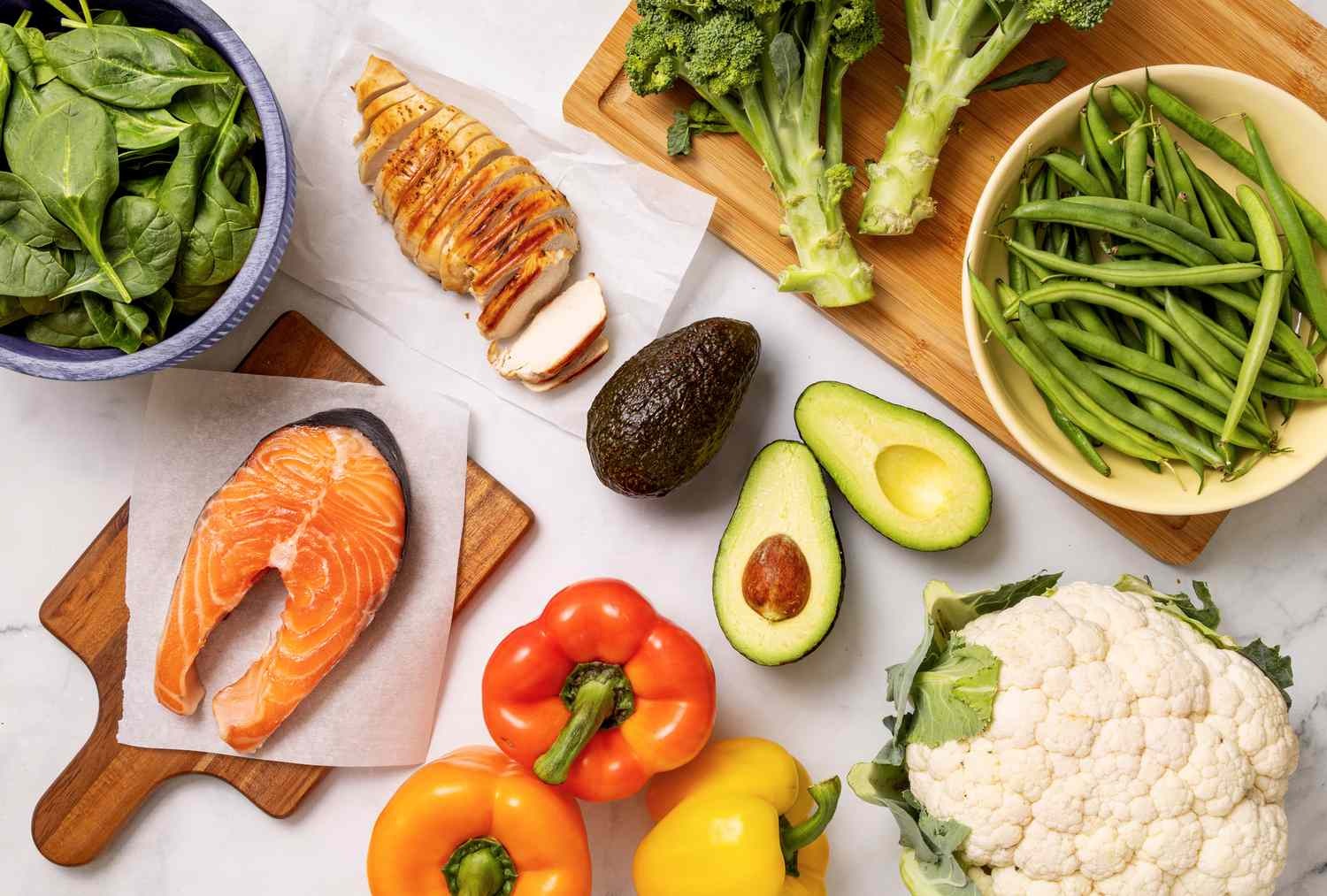The ketogenic diet, often referred to as the keto diet, has become a popular approach for weight loss and improving overall health. By drastically reducing carbohydrate intake and focusing on healthy fats, the body enters a state called ketosis, where it burns fat for energy instead of glucose. However, the success of a keto diet hinges on knowing which foods to eat and which to limit. This comprehensive guide provides a detailed keto diet food list to help you make informed choices.
Foods You Can Eat on the Ketogenic Diet
The keto diet focuses on foods that are low in carbohydrates, moderate in protein, and high in healthy fats. Below is a detailed breakdown of the best foods for your ketogenic lifestyle:
Fish & Seafood
Fish and seafood are excellent keto-friendly options as they are low in carbs and rich in healthy fats, protein, and essential nutrients:
- Salmon: Loaded with omega-3 fatty acids, which support heart and brain health.
- Mackerel & Sardines: High-fat fish that provide essential fatty acids.
- Shrimp, Crab, & Lobster: Carb-free seafood that adds variety to your meals.
- Oysters & Mussels: Low in carbs and packed with minerals like zinc and magnesium.
Pro Tip: Aim to eat fatty fish like salmon at least twice a week for maximum health benefits.

Veggies
Non-starchy vegetables are a cornerstone of the keto diet. They are rich in vitamins, minerals, and fiber while being low in carbs. Some keto-approved veggies include:
- Leafy Greens: Spinach, kale, and arugula are perfect for salads or sautéed side dishes.
- Cruciferous Vegetables: Broccoli, cauliflower, and Brussels sprouts are versatile and nutrient-dense.
- Zucchini: Great for zoodles or casseroles.
- Bell Peppers (in moderation): Provide color, flavor, and antioxidants.
Tip: Stick to vegetables that grow above ground to keep your carb intake low.

Cheese
Cheese is a favorite among keto dieters for its rich flavor and nutritional profile. It’s high in fat, low in carbs, and versatile in recipes:
- Cheddar & Mozzarella: Great for snacks or melted over dishes.
- Cream Cheese: A base for keto desserts and creamy sauces.
- Parmesan: Perfect for garnishing salads or keto-friendly pasta substitutes.
Note: Enjoy cheese in moderation, as it can be calorie-dense.

Dairy
Full-fat dairy products are a staple on the keto diet due to their high-fat content. Some options include:
- Butter & Ghee: Use for cooking or adding to keto coffee (bulletproof coffee).
- Heavy Cream: Ideal for making creamy soups, sauces, or adding to beverages.
- Full-Fat Greek Yogurt: A great source of protein and fat, but watch your portion size to avoid excess carbs.
Avocados
Avocados are a superfood on the keto diet. They are loaded with heart-healthy monounsaturated fats, fiber, and potassium:
- Enjoy them in salads, as guacamole, or simply sliced with a sprinkle of salt and pepper.
Why Choose Avocados? They’re nutrient-dense and help maintain electrolyte balance on keto.

Meat & Poultry
Meat and poultry are key sources of protein and fat on the keto diet. Opt for unprocessed and grass-fed options whenever possible:
- Beef: Ribeye, ground beef, and steak are keto favorites.
- Chicken: Go for thighs and wings, which are higher in fat compared to chicken breast.
- Pork: Include bacon (in moderation), pork chops, and sausage (check for added sugars).
Cooking Tip: Use healthy fats like butter, ghee, or olive oil for cooking meat.

Eggs
Eggs are one of the most versatile and affordable keto foods. They’re rich in protein, healthy fats, and essential vitamins:
- Scramble them, boil them, or make keto-friendly omelets packed with low-carb veggies and cheese.
Bonus: Eggs are easy to prepare and perfect for meal prepping.

Nuts, Seeds & Healthy Oils
These provide healthy fats, fiber, and nutrients essential for keto success:
- Nuts: Almonds, walnuts, pecans, and macadamia nuts are great for snacking.
- Seeds: Chia seeds, flaxseeds, and sunflower seeds can be added to salads or smoothies.
- Healthy Oils: Include olive oil, avocado oil, and coconut oil for cooking or dressings.
Note: Some nuts, like cashews, are higher in carbs and should be consumed sparingly.

Berries
While most fruits are too high in carbs for keto, berries are an exception. They are low in sugar and packed with antioxidants:
- Strawberries: Sweet yet low in carbs.
- Raspberries & Blackberries: Perfect for adding to keto desserts or eating as a snack.
Tip: Stick to small portions to keep your carb intake in check.

Unsweetened Coffee & Tea
Beverages like coffee and tea are keto-approved, provided they’re unsweetened:
- Add heavy cream or coconut milk for a rich, creamy texture.
- Use keto-friendly sweeteners like stevia or erythritol if needed.
Fun Fact: Many keto dieters enjoy bulletproof coffee for an energy boost in the morning.

Dark Chocolate
Craving something sweet? Dark chocolate with at least 70% cocoa is a keto-friendly option:
- Choose brands with minimal added sugar.
- Pair with a handful of nuts for a decadent treat.
Note: Keep portions small to stay within your carb limits.

Foods to Limit on the Keto Diet
While the keto diet allows for a wide variety of foods, certain items should be consumed sparingly to maintain ketosis. Here’s what to limit:
- High-Carb Vegetables: Avoid starchy vegetables like potatoes, corn, and carrots, as they contain more carbs than keto allows.
- Grains & Legumes: Foods like bread, pasta, rice, beans, and lentils are too high in carbs for keto.
- Fruits: Most fruits, including bananas, apples, and oranges, are high in natural sugars and should be limited.
- Sugary Foods & Drinks: Avoid candy, cakes, soda, and sweetened beverages. Even natural sweeteners like honey and maple syrup are off-limits.
- Low-Fat & Flavored Dairy: Stick to full-fat options and avoid products with added sugars or artificial flavorings.
- Alcohol: Some alcoholic beverages, like beer and sweet cocktails, are high in carbs. Opt for dry wine or spirits like vodka and whiskey in moderation.
Conclusion
The keto diet revolves around low-carb, high-fat foods that help your body achieve and maintain ketosis. By focusing on healthy fats, moderate protein, and nutrient-rich vegetables while limiting high-carb foods, you can enjoy the many benefits of this lifestyle. Keep this keto diet food list handy as you plan your meals and grocery shopping. With the right choices, transitioning to keto becomes much easier, and you’ll be on your way to achieving your health and fitness goals in no time!



